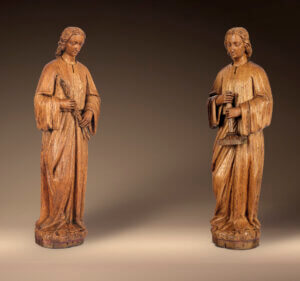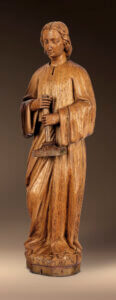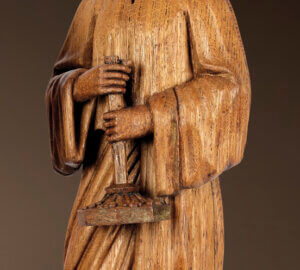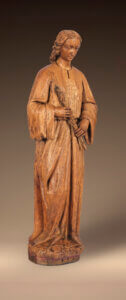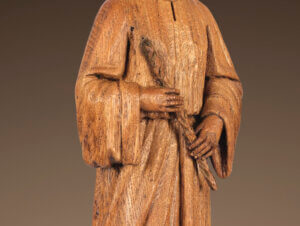This extraordinary pair of angels consists of two elongated figures in a calm pose. The floor-length gowns with wide sleeves and straight pleats reflect a timeless elegance. Stylistically, they can be attributed to the circle of the Utrecht sculptor Adriaen van Wesel. Utrecht was a highly significant art center in the Middle Ages, which was shaped by the artistic works of this sculptor. Van Wesel was also a member of the city council and numerous documents relating to his commissions have been preserved.
His figures are characterized by an oval head with a high forehead, framed by wavy, shoulder-length hair parted in the middle. Sharp eyebrow ridges lie above almond-shaped, only slightly open eyes with prominent eyelids, which are emphasized by the lowered gaze. The elongated nose with a straight nasal bridge sits above a mouth contorted into a slight smile, rounded off by a small chin. The androgynous figures are recognizable by the recesses for the wings on the back, which were originally inserted separately. Their vestments show a rather withdrawn drapery and the triangular folds lying almost doughy on the ground resemble those of the angels from around 1485/1500 from the Südlohn parish church, which is dedicated to St. Vitus. The almost luxuriously polished surface texture and other physiognomic features, such as the texture of the hair and the shape of the eyes, show a close relationship to the figure of the Virgin Mary in a scene of the birth of Jesus, which was created around 1475-77 (Rijksmuseum, Amsterdam, BK-NM-11713).
The pair interact with each other through their gestures and attributes: One of the angels holds the shaft of a magnificent candlestick, decorated with flowers, in front of his body and turns towards the other angel, who is carrying a long, twisted candle. You are probably in the process of fitting the candle to the candlestick and lighting it. In Christianity, the candle symbolizes life and the eternal light shows the presence of God. The candle can also be seen as an apotropaic or ominous symbol. These are not the typical candlestick angels, which themselves function as candlesticks, or the more frequently depicted angels playing music. This pair of angels is performing an act of devotion, namely lighting a candle. This is a rarity and fits in with van Wesel’s oeuvre, whose tendency towards iconographic innovation is considered an important feature of his sculptures. In this way, viewers are shown a sacred act, which is probably intended to call them to imitation and devout prayer.
Literature:
W. Halsema-Kubes, G. Lemmens and Guido de Werd (eds.), Adriaen van Wesel: een Utrechtse beeldhouwer uit de late middeleeuwen, exhibition catalog of the Rijksmuseum, Amsterdam 1980.
R. Karrenbrock, Unknown works by the Utrecht sculptor Adriaen van Wesel, in: Zeitschrift für Kunstgeschichte 3, 1994, pp. 336-346.
J. Leeuwenberg, Een nieuw facet aan de Utrechter beeldhouwkunst IV, in: Oud Holland 75, 1960, pp. 105-205.
LINKS:
https://artsandculture.google.com/asset/südlohn-catholic-parish-church-st-vitus/HgHSe2HLj0vTrA?hl=en
https://www.rijksmuseum.nl/en/collection/BK-NM-11713/catalogue-entry?pdfView=False
Cf.
